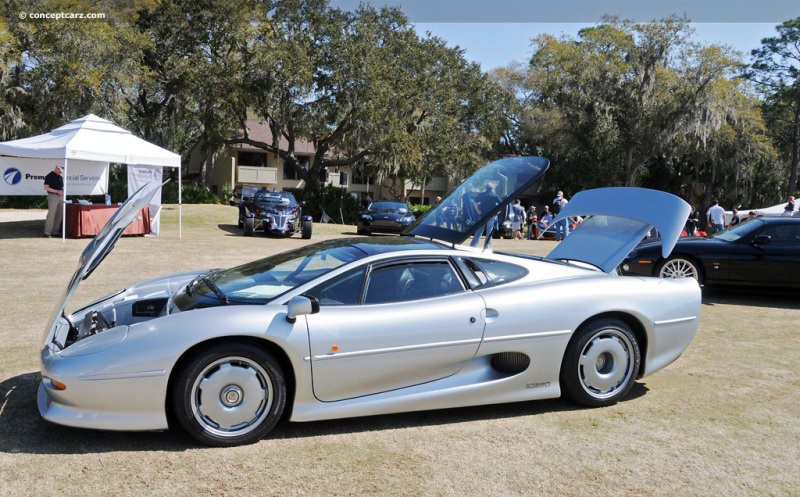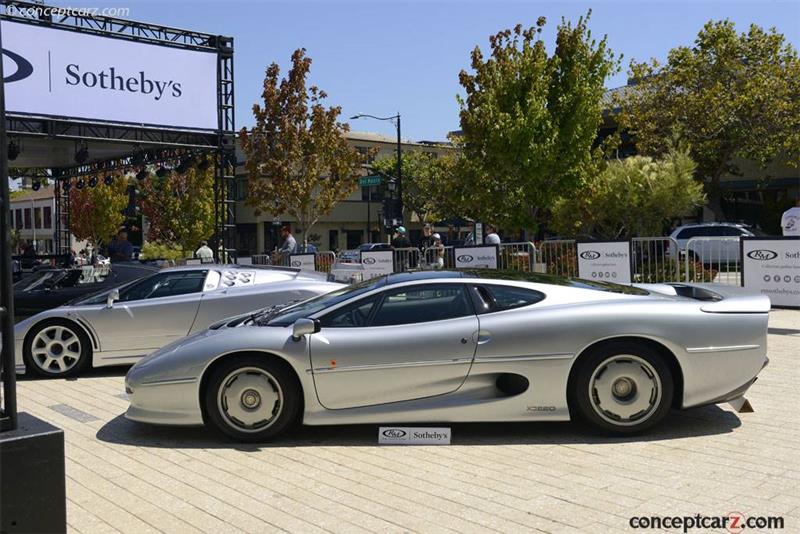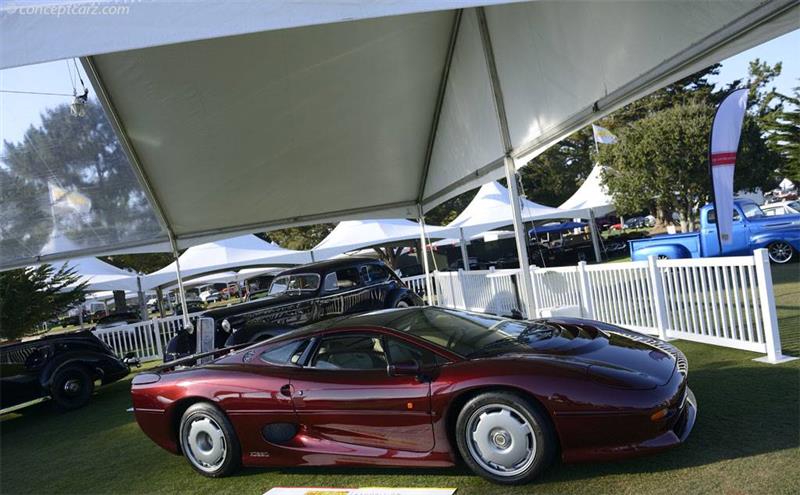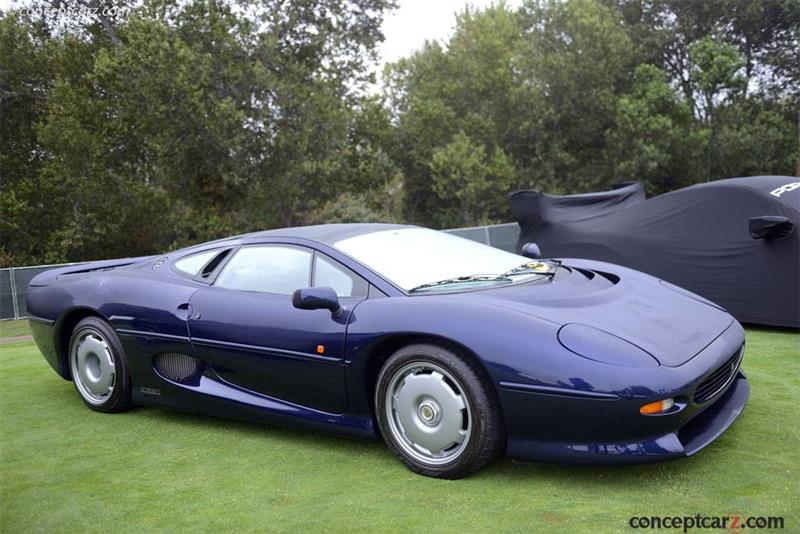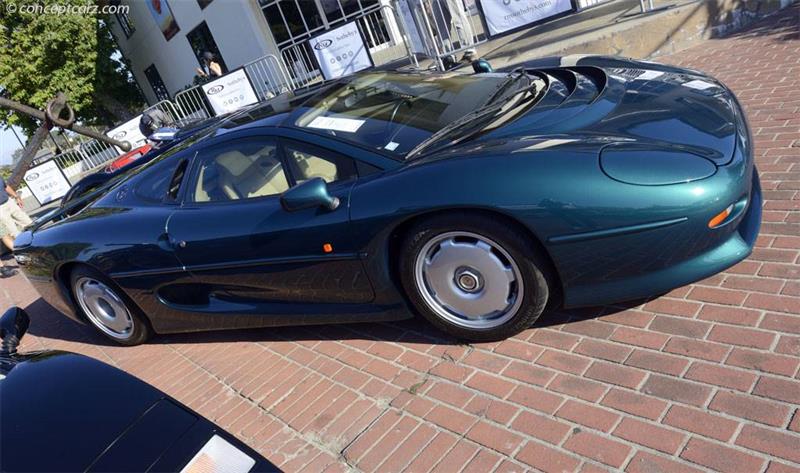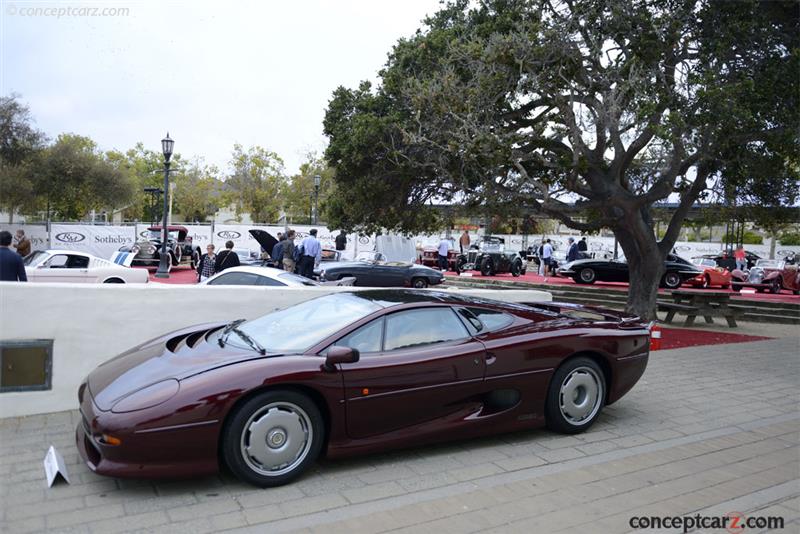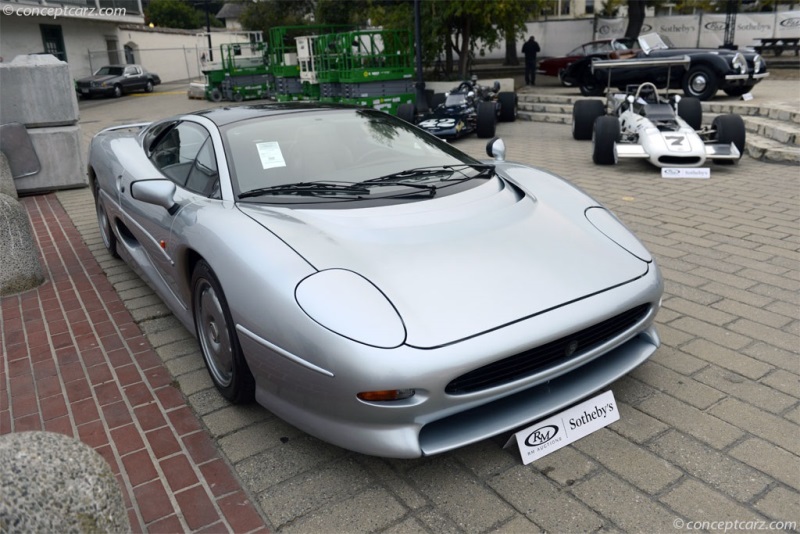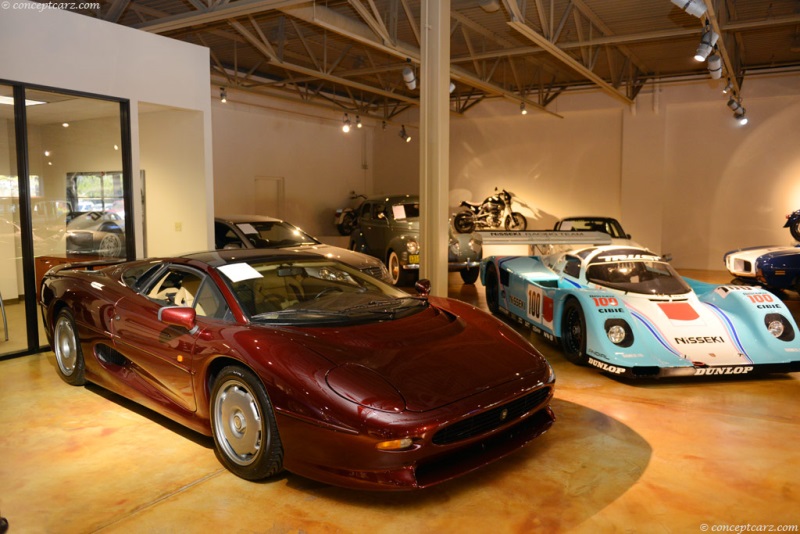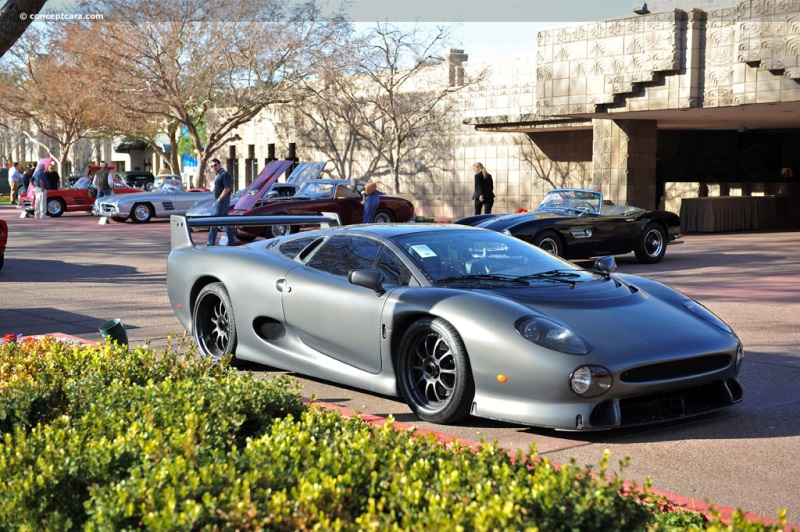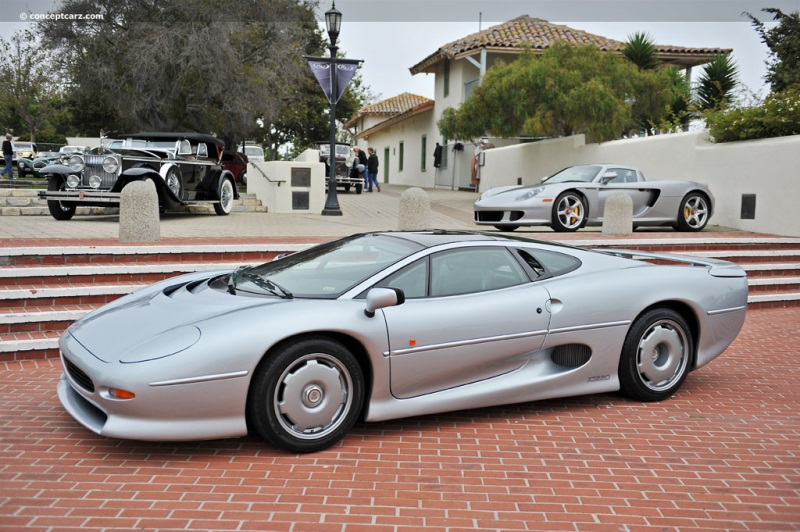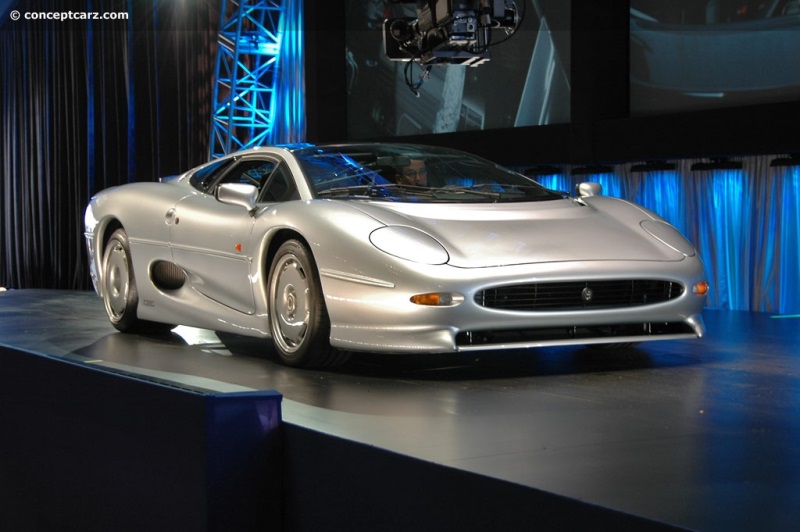The Jaguar XJ220 two-seat supercar was produced from 1992 until 1994 with 282 examples built. It was a joint venture between Jaguar and Tom Walkinshaw Racing (TWR). TWR was founded in 1976 by Tom Walkinshaw and initially handled privateer work before entering Works racing cars for manufacturers such as Rover and Mazda. Several victories were won in 1982 with the Jaguar XJS in the European Touring Car Championship, helping to establish a relationship with Jaguar that would continue into the 1990s.In 1984, Jaguar and TWR won the European Touring Car Championship with the XJS. For the 1985 season, TWR and Jaguar developed the XJR-6 to contest the FIA Group C World Sportscar Championship. It was powered by the same Jaguar V12 engine found in the Group 44 Racing XJR-5 used for the IMSA GT Championship. In 1988, TWR oversaw the IMSA GT Championship operation with the XJR-9, which would go on to win the 1988 24 Hours of Le Mans and World Sportscar Championship in the same year. New rule regulations were introduced that restricted refueling during races, which forced the team to seek a replacement for the thirsty V12 engines. They found a suitable replacement from the normally-aspirated Austin Rover V64V engine, designed for the MG Metro 6R4. The small-displacement, turbocharged engine was compact, lightweight, and fuel-efficient. With design rights secured, JaguarSport began work on the development of a purpose-built six-cylinder engine to power the XJR-10 (IMSA) and XJR-11 (Group C). Two versions were needed, a 3-liter unit for the American IMSA series and a 3.5-liter to contest the Group C category of the World Championship, which included the high-speed 24 Hours of LeMans. JaguarSport's Tony Southgate, with the help of Ross Brawn, designed and built an all-new chassis to house the bespoke V6 engine. The all-aluminum engine had twin overhead camshafts, four valves per cylinder, and two Garrett turbochargers. In 3-liter form, the engine offered approximately 650 horsepower. The Group C version produced around 750 horsepower. Both engines were backed by a five-speed gearbox which also served as a fully stressed member of the chassis. 
Coupe
Chassis #: SAJJEAEX8AX220701
Engine #: 6A 10344 SB
View info and history
Auction entries : 3The XJR-10 and XJR-11 would be used for two seasons and earn seven victories. XJ220 Design and Development
What had begun as production cars modified for racing, had evolved into purpose-built race cars that were far removed from the Jaguar and made available to the general public. Jaguar and their Director of Engineering, Jim Randle, decided to design and build a car that was built 'in house' and was capable of winning at Le Mans. With no official support, Randle and a team of volunteers worked on evenings and weekends in their own time. Two cardboard model mock-ups were produced, with one by Keith Helfet using design cues from the current XJ41 project and Malcolm Sayer's work on the XJ13 racing car. Helfet's design was selected and work began on building a concept. With a shoe-string budget, work began on a mid-engine, all-wheel-drive concept powered by a Jaguar V12 engine. It was given the name XJ220 as a continuation of the naming of the XK120, which was in reference to the top speed of the model in miles per hour. The targeted speed of the XJ220 was 220 mph. When the XJ220 made its debut in the concept-car form at the British International Motor Show in October of 1988, it was just a few hours old. It had been completed just eight hours before its debut. Up to this point in history, Jaguar had experience with just rear-wheel drive vehicles. Randle had Tony Rolt's company, FF Developments, design the transmission and four-wheel-drive system for the XJ220. The mid-mounted engine complicated the design of the four-wheel-drive system as an ingenious solution was needed to get the power to the front wheels. The solution implemented used the front-wheel-drive from the central differential on the rear transaxle and sent it through the V in the center of the engine using a quill drive, before joining an inverted differential. AP Racing designed the twin-plate clutch. The engine was a leftover unit TWR had manufactured during the 1980s. These 7-liter engines had been used in the LeMans-winning Silk Cut XJR-9, and five of the engines still existed, all with dry-sump lubrication, which would be useful as the dry-sump would lower the vehicle's center of gravity. A displacement of 6.2-liters was selected and the examples fitted into the XJ220 concept were given titanium connecting rods.
Coupe
Chassis #: SAJJEAEX8AX220707
View info and history
Auction entries : 2The engine was installed into a chassis that was manufactured from aluminum using Alcan's bonded aluminum structure vehicle technology (ASVT). The wheelbase measured 112 inches and the adjustable height suspension was more tuned for road use. The fuel tank was located behind the center bulkhead, and a four-channel anti-lock braking system was placed at all four corners. Complicating the design complexity even further, the XJ220 Concept was given rear-wheel steering. The production versions were shorter than the concept.A week before the introduction of the XJ220, Jaguar chairman John Egan and Roger Putnam were shown the vehicle and signed off on the concept, allowing it to be unveiled. The car was very well received, an impressive accomplishment considering the Ferrari F40 was also on display at the same event.
Coupe
Chassis #: SAJJEAEX8AX220707
View info and history
Auction entries : 2The Jaguar XJ220 had been designed as a concept car, but its positive reception prompted a production version. On December 20th of 1989, Jaguar announced that 220 to 350 examples would be produced, with planned deliveries for mid-1992. Jaguar was busy with production vehicles, such as the XJ and XJS models, and the newly facelifted XJS was introduced in May of 1991. So production for the XJ220 was tasked to TWR and Jaguar Sport, a joint venture between Jaguar and TWR that was formed in 1987 with the purpose of producing racing cars. JaguarSport formed a new company, Project XJ220 Ltd., specifically to develop and build the XJ220. Mike Moreton was hired to head the TWR team and to run the XJ220 project. Keith Helfet and Nick Hull were retained to refine the interior and exterior designs. Unlike the concept version, the production XJ220 used a 3,498cc twin-turbocharged V6 engine, which was given the designation Jaguar TWR JV6. It was a significantly altered version of the naturally aspirated Austin Rover V64V V6 engine. In comparison to the V12, the V6 was more compact, lighter, and easier to meet emissions regulations. The new turbocharged engine, codenamed JV6, was built under the auspices of Allan Scott. It had a 90-degree bank angle, belt-driven double overhead camshafts, four valves per cylinder, and shared several design features with the Cosworth DFV Formula One engine. It had dry-sump lubrication, multi-point fuel injection with dual injectors, and Zytek electronic engine management. It was comprised of an aluminum cylinder block, aluminum cylinder heads, steel connecting rods, and a steel crankshaft. The 540 horsepower engine was capable of carrying the XJ220 from zero-to-sixty mph in 3.6 seconds and had a top speed of 212.3 mph. 
Coupe
Chassis #: SAJJEAEX8AX220701
Engine #: 6A 10344 SB
View info and history
Auction entries : 3Emission regulations required the exhaust system to be fitted with two catalytic converters, robbing the engine of some of its power. One example had the catalytic converters removed and its rev limit increased, adding an additional 50 horsepower and bringing the top speed to 217 mph. Since the complexity of the four-wheel-drive system would increase costs, hinder the development process, and be potentially problematic for the customer, a less complicated rear-wheel-drive setup was selected. FF Developments were selected to provide the gearbox and transaxle assembly. A six-speed gearbox was considered, but a five-speed gearbox was deemed adequate. To improve traction, the transaxle was fitted with a viscous coupling limited-slip differential. The first two gears were given triple-cone synchromesh to cope with quick starts. The 8.5-inch diameter clutch was provided by AP Racing. Abbey Panels constructed the aluminum body panels for the XJ220. Keith Helfet worked on the exterior redesign, which was necessary due to the altered wheelbase and length, and the removal of the scissor doors. Larger air intakes were needed to feed air to the turbocharged engine and the two intercoolers. Additional changes were added after wind tunnel testing revealed areas of improvement. Underbody airflow and venturi effect were added, making the XJ220 one of the first road cars to intentionally use this design to help increase downforce at speed. 
XJ220S Coupe
Chassis #: 784
View info and history
Auction entries : 1The luxurious interior featured leather-trimmed sports seats, electrically adjustable heated mirrors, and electric windows. A small luggage area could be found directly behind and above the rear portion of the engine, trimmed in leather. Production rates averaged about one car per day, and the first customer car was delivered in June of 1992. The last XJ220 was built in April of 1994. Although the production version of the XJ220 offered spectacular performance, some clients who left deposits after seeing the original concept car were unsatisfied with a twin-turbocharged V6 and lack of four-wheel drive. This resulted in several customers deciding not to take delivery, resulting in a number of XJ220s being left unpurchased at the factory. A racing version was introduced at the 1993 Autosport International motor show; given the model name XJ220-C, it was built to compete in FISA GT racing.
Coupe
Chassis #: SAJJEAEX8AX220719
View info and history
Auction entries : 1In 1995, a special XJ220 was built for the Sultan of Brunei and his brother Prince Jefri. It wore a redesigned body by Pininfarina and was manufactured by Coggiola. Changes included new rear lights with a redesigned double-vane rear wing, a new interior package, and fixed headlights.
by Daniel Vaughan | Dec 2019
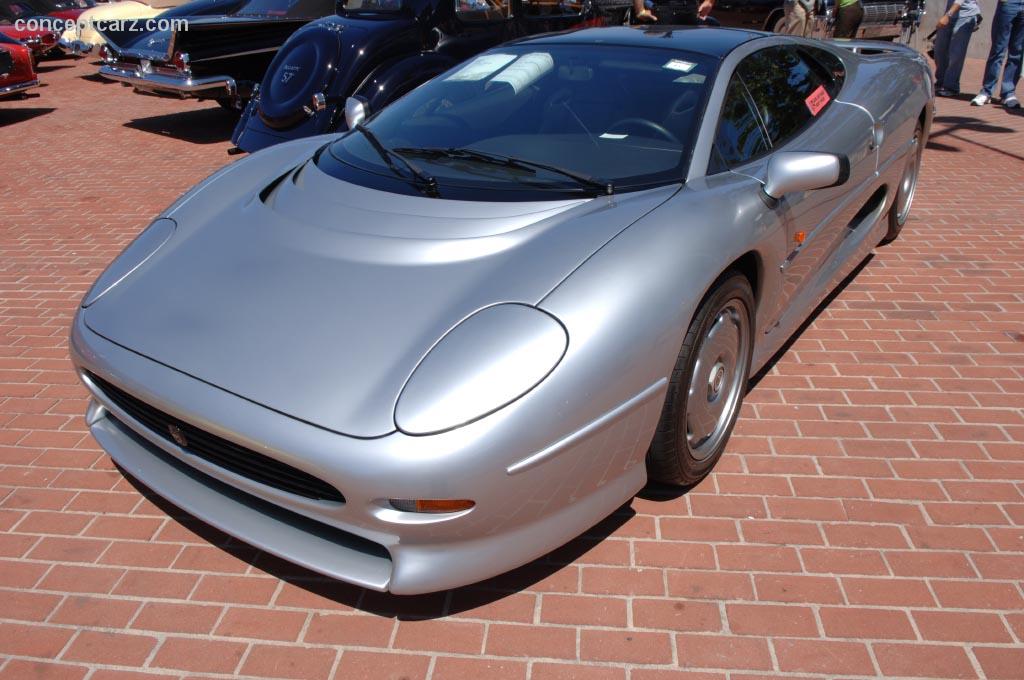
Coupe
Chassis #: SAJJEAEX8AX220701
Engine #: 6A 10344 SB
View info and history
Auction entries : 3
What had begun as production cars modified for racing, had evolved into purpose-built race cars that were far removed from the Jaguar and made available to the general public. Jaguar and their Director of Engineering, Jim Randle, decided to design and build a car that was built 'in house' and was capable of winning at Le Mans. With no official support, Randle and a team of volunteers worked on evenings and weekends in their own time. Two cardboard model mock-ups were produced, with one by Keith Helfet using design cues from the current XJ41 project and Malcolm Sayer's work on the XJ13 racing car. Helfet's design was selected and work began on building a concept. With a shoe-string budget, work began on a mid-engine, all-wheel-drive concept powered by a Jaguar V12 engine. It was given the name XJ220 as a continuation of the naming of the XK120, which was in reference to the top speed of the model in miles per hour. The targeted speed of the XJ220 was 220 mph. When the XJ220 made its debut in the concept-car form at the British International Motor Show in October of 1988, it was just a few hours old. It had been completed just eight hours before its debut. Up to this point in history, Jaguar had experience with just rear-wheel drive vehicles. Randle had Tony Rolt's company, FF Developments, design the transmission and four-wheel-drive system for the XJ220. The mid-mounted engine complicated the design of the four-wheel-drive system as an ingenious solution was needed to get the power to the front wheels. The solution implemented used the front-wheel-drive from the central differential on the rear transaxle and sent it through the V in the center of the engine using a quill drive, before joining an inverted differential. AP Racing designed the twin-plate clutch. The engine was a leftover unit TWR had manufactured during the 1980s. These 7-liter engines had been used in the LeMans-winning Silk Cut XJR-9, and five of the engines still existed, all with dry-sump lubrication, which would be useful as the dry-sump would lower the vehicle's center of gravity. A displacement of 6.2-liters was selected and the examples fitted into the XJ220 concept were given titanium connecting rods.
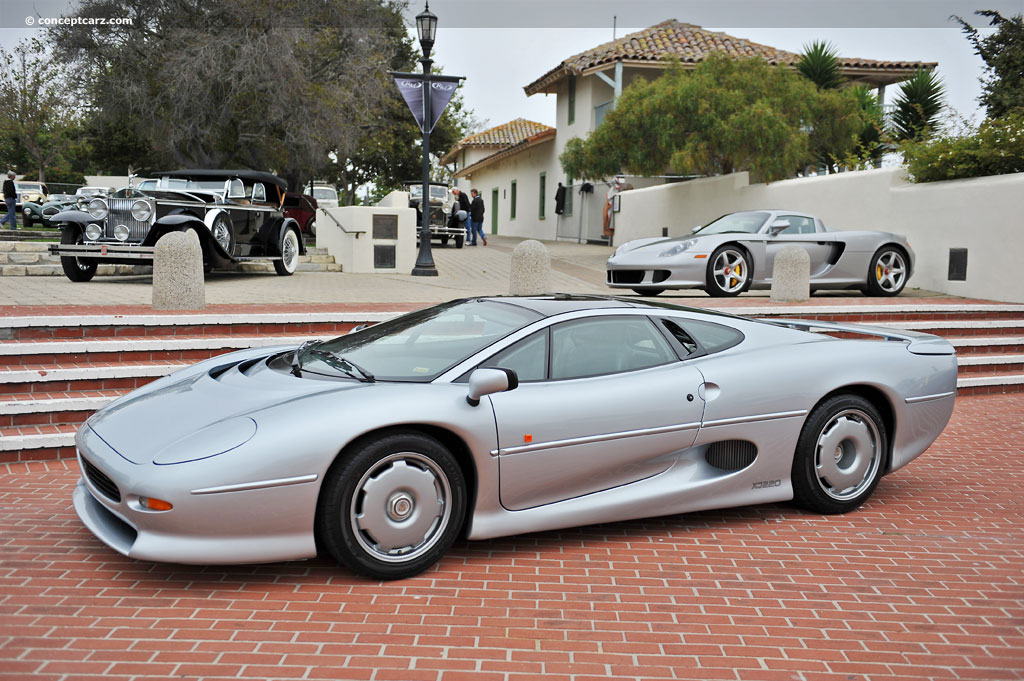
Coupe
Chassis #: SAJJEAEX8AX220707
View info and history
Auction entries : 2
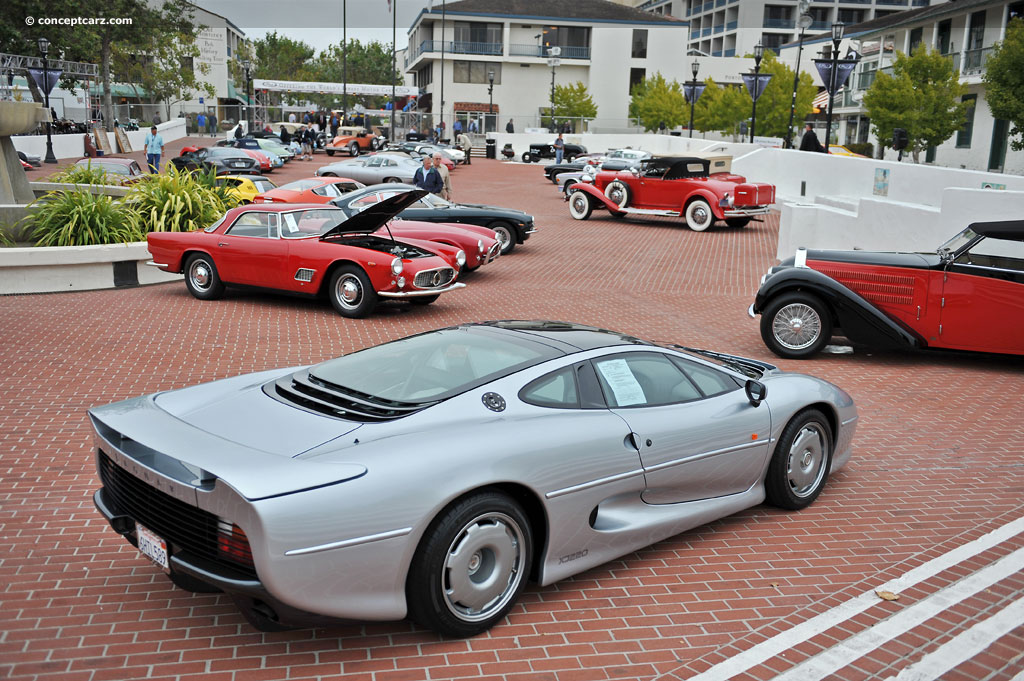
Coupe
Chassis #: SAJJEAEX8AX220707
View info and history
Auction entries : 2
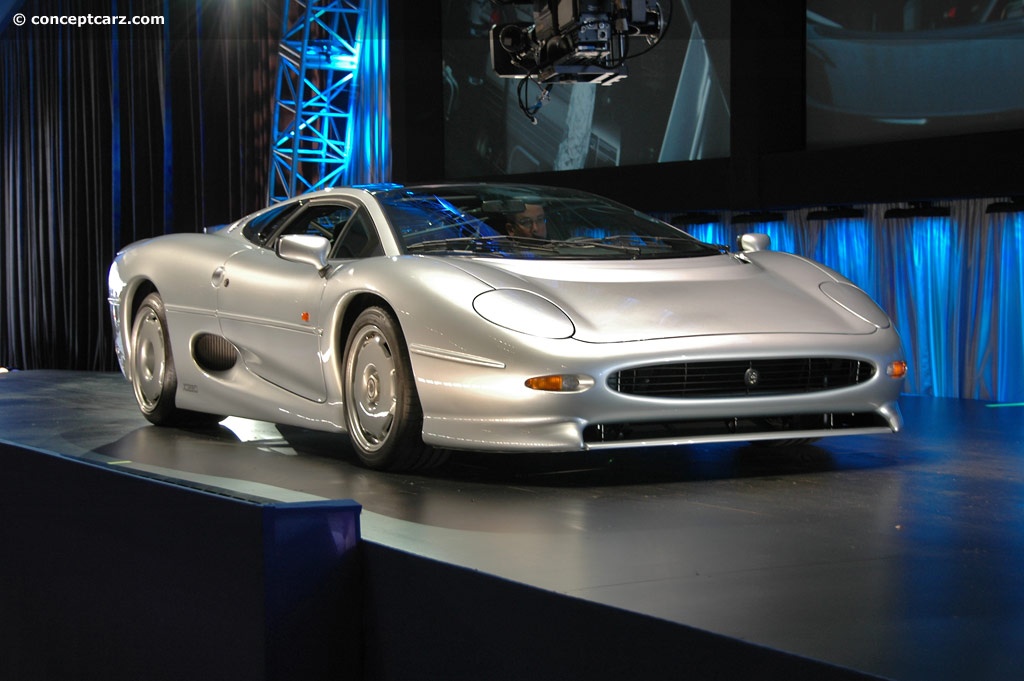
Coupe
Chassis #: SAJJEAEX8AX220701
Engine #: 6A 10344 SB
View info and history
Auction entries : 3
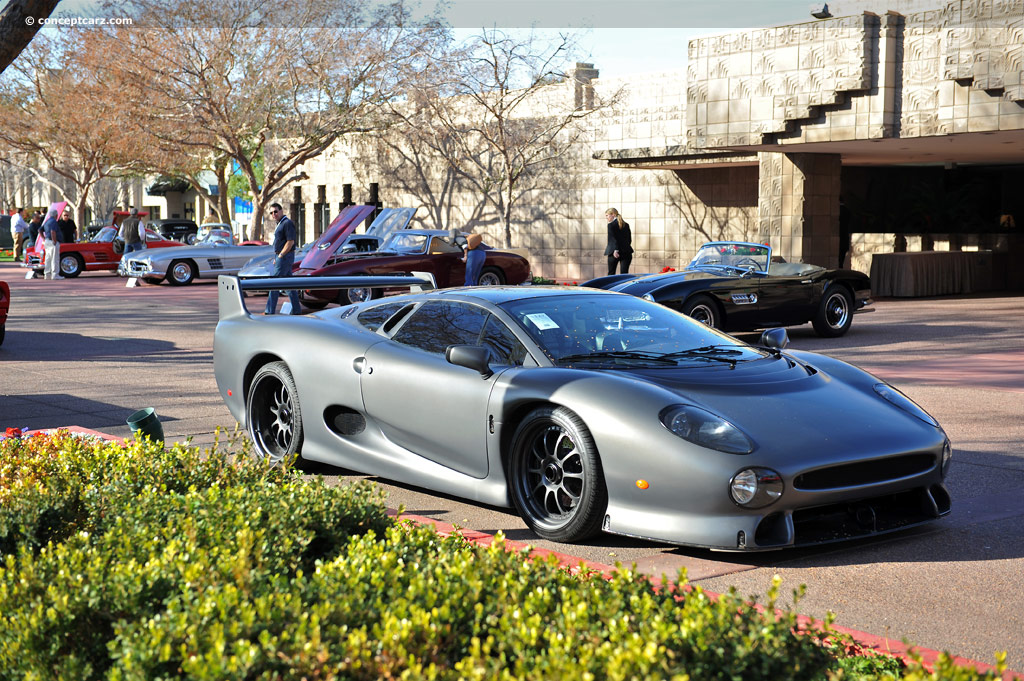
XJ220S Coupe
Chassis #: 784
View info and history
Auction entries : 1
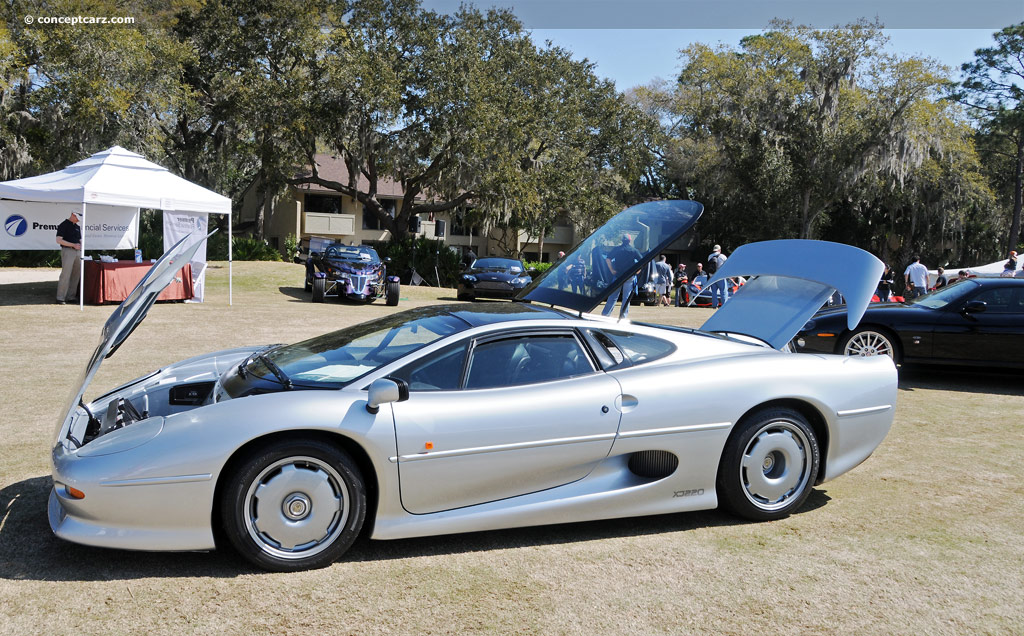
Coupe
Chassis #: SAJJEAEX8AX220719
View info and history
Auction entries : 1
by Daniel Vaughan | Dec 2019
Related Reading : Jaguar XJ220 History
There are very few production cars that can claim to be have been born out of a spare-time project, but the Jaguar XJ220 is the most famous of all. Jaguars chief engineer, Jim Randle, dreamt up the idea of creating the ultimate supercar on Christmas and fired up enough enthusiasm with colleagues to start a Saturday club to work on the project. At first not even the Jaguar board knew about the....
Continue Reading >>
Continue Reading >>
Related Reading : Jaguar XJ220 History
Between 1992 and 1994, the Jaguar XJ220 was produced by Jaguar in collaboration with Tom Walkinshaw Racing as Jaguar Sport and is a mid-engined sports vehicle. Until the McLaren F1 arrived in 1994, the XJ220 held the record for the highest top speed of a production vehicle of 217 mph. The Saturday Club was a very informal group made up of certain Jaguar employees in the early days of the company,....
Continue Reading >>
Continue Reading >>
Similar Automakers
Similarly Sized Vehicles
from 1993
1993 Jaguar XJ220 Vehicle Profiles
Recent Vehicle Additions
Related Automotive News

Great British Racing: Get up close to legends of UK Motorsport at London Concours 2024
Four-wheel icons of race and rally from the 1960s to the 1990s will be on display at the capitals top concours delegance.
The Hesketh 308E that epitomised the excesses of Formula 1 in the Seventies, the outrageously over-engined Metro 6R4 rally...

1993 Jaguar XJ220 Supercar Debuts on Collecting Cars Global Auction Platform
LeMans Blue Model Has Only 2,652 Miles (4,269 KM) On Odometer
An extremely rare 1993 Jaguar XJ220 with only 2,652 miles (4,269 KM) on its odometer has just hit the Collecting Cars global auction block. International bidding will extend through...

Pride Of Big Cats Goes On The Prowl At 'Emotional' Silverstone Reunion
Record-breaking collection of Jaguar XJ220s congregate at Silverstone Classic
David Brabham reunited with class-winning Le Mans car
Evocative track parade including cars from as far afield as Japan
Fitting tribute to what was once the worlds f...

2017 JAGUAR XE DEBUTS IN LOS ANGELES WITH AWD AND APPLE WATCH CONNECTIVITY
- Award-winning Jaguar XE sports sedan to arrive in U.S. Jaguar showrooms Spring 2016
- Lineup to include Jaguar XE 20d, 25t and 35t models selectively available in XE, XE Premium, XE Prestige and XE R-Sport trims
- All models offered in rear-wheel drive...
2014 MERCEDE-BENZ M-CLASS: ALL M-CLASS MODELS FEATURE COLLISION PREVENTION ASSIST
May 08, 2014 - MONTVALE, NJ - The 2014 Mercedes-Benz M-Class sport utility has COLLISION PREVENTION ASSIST as standard equipment on all four 2014 M- Class models. Using a dedicated radar sensor to monitor the distance to a vehicle in front and...
Vehicle information, history, and specifications from concept to production.






























